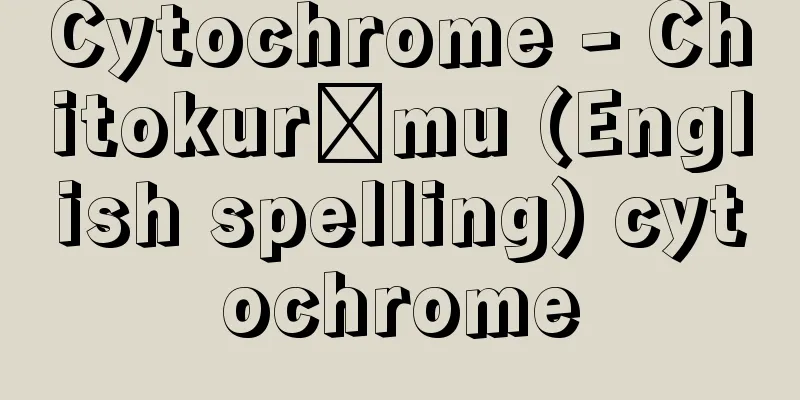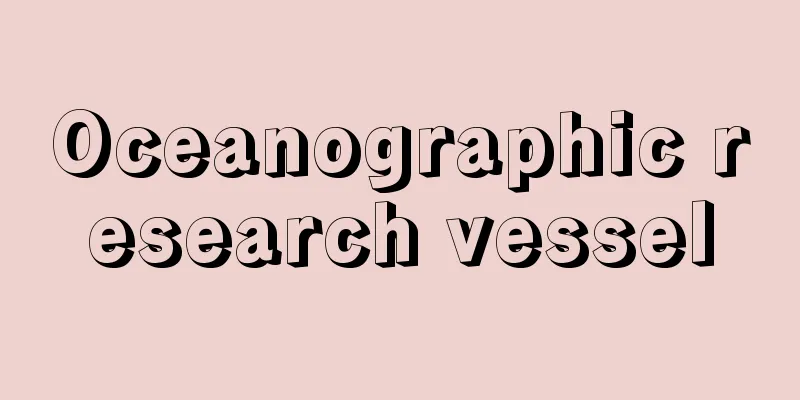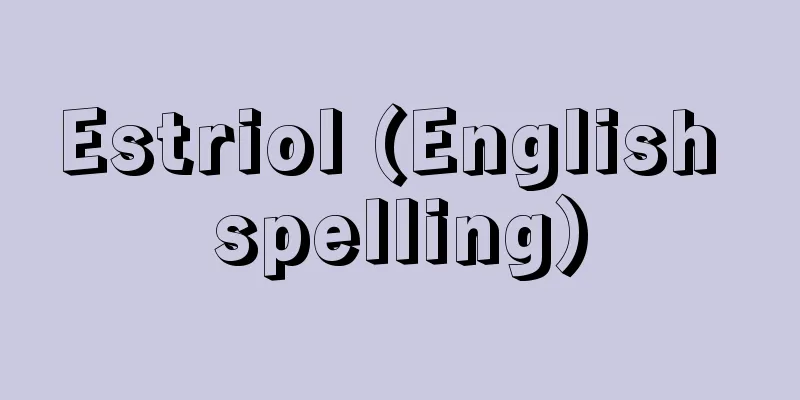Cytochrome - Chitokurōmu (English spelling) cytochrome

|
A general term for hemoproteins present in living cells, excluding hemoglobin, myoglobin, peroxidase, and catalase. Also called cytochrome, it belongs to the pigment protein category. In 1884, CA MacMunn (1852-1911) discovered a red pigment with an absorption band similar to that of hemin in animal muscles, which he named myohematin or histohematin. Later, in 1925, British biochemist Keilin discovered that this pigment is widely present in aerobic organisms and is involved in cellular respiration, and proposed to call it cytochrome, meaning cellular pigment. Cytochromes are widely present in the cells of animals and plants, bacteria, molds, yeasts, etc., and have also been found in some obligate anaerobes that were initially thought not to exist. Normally, several types of cytochromes are bound to mitochondria and other large particles in a single cell, and they work together as the central players in cellular respiration. That is, cytochromes act as intermediate electron carriers in the redox reaction in cells by reversible conversion of heme iron from Fe2 + to Fe3 + . Reduced cytochromes have strong absorption bands in the visible region, but these differ depending on the structure of iron porphyrin and the state of binding with proteins. In relation to this, the absorption spectrum, redox potential, ease of separation of iron porphyrin from protein, and functions vary from one to another. The main types are cytochromes a, a3 , b, b2 , b5 , b6 , c, c1 , d, and p-450. Cytochromes are generally strongly bound to intracellular particles and cannot be extracted as a solution using mild methods, so few are extracted in their pure, undenatured form. Active cytochromes that have been isolated and crystallized include animal and yeast cytochrome c and yeast cytochrome b2 . For example, animal cytochromes a (including a3 ), b, and c are extracted from myocardial gruel at pH 7.4 using the surfactant sodium cholate (cholic acid is the main component of bile acids), and purified by ammonium sulfate precipitation, ion exchange chromatography, and ammonium sulfate salting out. Among the cytochromes, cytochrome c is water-soluble and relatively easy to extract, so its structure and function have been studied in detail by Swedish biochemist Theorell and others. Horse myocardial cytochrome has a molecular weight of 13,000 and contains one heme molecule per molecule. It has 111 amino acid residues, with the majority being lysine (18), glycine (14), and glutamine (13), with three histidines and two cysteines. The heme is similar to that of hemoglobin, but the bond is different, with the sulfur of cysteine being strongly bonded by a thioether bond (thioether is also called sulfide). Cytochrome c is reduced by dehydrogenase, which transfers electrons from flavoenzymes to cytochrome c oxidase. Cytochrome oxidase is required for oxidation. The function of cytochrome b is to act as an intermediate electron carrier in the oxidation of succinate. It is reduced by dehydrogenase, but unlike cytochrome c, it can be oxidized by molecular oxygen even in the absence of cytochrome oxidase. Cytochrome a and a 3 act as the cytochrome aa 3 complex, exhibiting cytochrome c oxidase activity. Cytochrome d has the function of reducing nitrite. Cytochrome P-450 is a monooxygenase that involves flavoproteins. It is known that there are different molecular weights, but the molecular weight is about 50,000. In higher animals, it is abundant in the liver and adrenal cortex, and is involved in drug metabolism and bile acid production in the liver, and in the biosynthesis of steroid hormones from cholesterol in the adrenal cortex, making it extremely important clinically. [Michiko Iijima] "Cytochromes and Cellular Respiration: The Path to Establishing the Electron Transport Chain, Volumes 1 and 2, by David Keilin, translated by Yamanaka Takeo and Okunuki Kazuo (1987, Society Publishing Center)" ▽ "Bio-Polymer Research Methods 1: Protein Design Using Genetic Recombination, edited by the Society of Polymer Science, Bio-Polymer Study Group (1987, Society Publishing Center)" ▽ "Proteins 2: Structure and Function, edited by Katsube Yukiteru et al. (1988, Tokyo Kagaku Dojin)" ▽ "Cytochrome P-450, by Takemori Shigeki and Konan Shiro (1990, University of Tokyo Press)" ▽ "Biochemistry of Oxygen: Mechanism of Diatomic Oxygen Reactions, by Lloyd L. Ingraham et al., translated by Matsuo Mitsuyoshi (1991, Society Publishing Center)" ▽ "The Cutting Edge of Organic Synthesis: Reaction Design and Control, edited by Mukaiyama Mitsuaki (1992, Tokyo Kagaku Dojin)" ▽ "Biochemistry of Respiratory Enzymes" by Yamanaka Takeo (1993, Kyoritsu Shuppan)" ▽ "Course in Clinical Anesthesiology 3" by Funae Yoshihiko et al. (1994, Shinko Trading Medical Book Publishing Division)" ▽ "New Science of Ligand Fields - Multi-Electron Theory in Physics, Chemistry and Biology" edited by Tanabe Yukito and edited by Kanno Akira et al. (1998, Kodansha)" ▽ "Advances in Chemical Engineering 32: Bioengineering" edited by the Society of Chemical Engineering (1998, Maki Shoten) ▽ "Physics of Living Organisms and Energy - The Source of Life Force" edited by the Physical Society of Japan (2000, Shokabo) ▽ "Electrons and Life - New Developments in Bioenergetics" edited by Kakiya Toshiaki and Mimuro Mamoru (2000, Kyoritsu Shuppan)" ▽ "New Mitochondrial Studies" edited by Utsumi Kosuke and Inoue Masayasu (2001, Kyoritsu Shuppan) [References] | | | | | | | | | | | | |Oxidoreductase| | protein| | | | | |Histidine| | | | | | | |©Shogakukan "> Major types of cytochromes Source: Shogakukan Encyclopedia Nipponica About Encyclopedia Nipponica Information | Legend |
|
生体細胞内に存在するヘムタンパク質のうち、ヘモグロビン、ミオグロビン、ペルオキシダーゼ、カタラーゼを除くものの総称。シトクロムともいい、色素タンパク質に属する。1884年にマクマンC. A. MacMunn(1852―1911)は動物の筋肉中にヘミンに似た吸収帯をもつ赤い色素が存在することを発見し、ミオヘマチンまたはヒストヘマチンと命名した。その後、1925年にイギリスの生化学者ケイリンは、この色素が好気性生物に広く存在して細胞呼吸に関与することを発見し、細胞色素という意味でチトクロムとよぶことを提案した。 一般の動植物の細胞、細菌、カビ、酵母などに広く存在しており、初めは存在しないと考えられていた絶対嫌気性菌の一部のものにもみいだされている。普通、一つの細胞には数種のチトクロムがミトコンドリアその他の大型粒子に結合しており、それらが協力して細胞呼吸の中心的存在として働く。すなわち、チトクロムはヘム鉄のFe2+Fe3+の可逆的変換により、細胞内の酸化還元反応の中間電子伝達体として働く。還元型チトクロムは可視部に強い吸収帯をもつが、鉄ポルフィリンの構造やタンパク質との結合状態により異なる。これと関連して、吸収スペクトル、酸化還元電位、鉄ポルフィリンとタンパク質との離れやすさ、機能などがそれぞれ異なってくる。おもなものとしては、チトクロムa、a3、b、b2、b5、b6、c、c1、d、p-450などがある。 チトクロム類は、一般に細胞内の粒子に強く結合しており、温和な方法で溶液として取り出すことができないので、未変性のまま純粋な状態で取り出されているものは多くはない。単離・結晶化され、活性のあるものとしては、動物や酵母のチトクロムc、酵母のb2などがある。製法の例をあげると、動物のa(a3を含む)、bおよびcは、心筋を粥(かゆ)状にしたものをpH7.4で界面活性剤のコール酸ナトリウム(コール酸は胆汁酸の主要成分)により抽出し、硫安沈殿、イオン交換クロマトグラフィー、硫安塩析によって精製する。チトクロム類のなかでもチトクロムcは水に溶けやすく、比較的容易に抽出できるので、スウェーデンの生化学者テオレルらにより構造と機能について詳しく研究されている。ウマの心筋のチトクロムについてみると、分子量は1万3000で、1分子中にヘム1分子を含む。アミノ酸残基は111個で、リジン(18)、グリシン(14)、グルタミン(13)が多く、ヒスチジン3個、システイン2個をもつ。ヘムはヘモグロビンのヘムとよく似ているが、その結合様式は異なり、システインの硫黄(いおう)によりチオエーテル結合で強く結合している(チオエーテルはスルフィドともいう)。チトクロムcは、フラビン酵素からチトクロムc酸化酵素へ電子を伝達する機能をもつ、デヒドロゲナーゼによって還元される。酸化されるためにはチトクロムオキシダーゼが必要である。チトクロムbの機能はコハク酸酸化における中間電子伝達体として働くことである。デヒドロゲナーゼによって還元されるが、チトクロムcと違ってチトクロムオキシダーゼがなくても、分子状酸素によって酸化される。チトクロムaとa3は、チトクロムaa3複合体としてチトクロムcオキシダーゼ作用を示す。チトクロムdの機能は、亜硝酸塩還元活性をもつ。チトクロムp-450は、フラビンタンパク関与のモノオキシゲナーゼである。分子量の異なるものの存在が知られるが、約5万である。高等動物では肝臓と副腎(ふくじん)皮質に多く、肝臓では薬物代謝や胆汁酸生成、副腎皮質ではコレステロールからステロイドホルモンへの生合成に関与しており、臨床的にはきわめて重要である。 [飯島道子] 『David Keilin著、山中健生・奥貫一男訳『チトクロムと細胞呼吸――電子伝達系確立への道』上下(1987・学会出版センター)』▽『高分子学会バイオ・高分子研究会編『バイオ・高分子研究法1 遺伝子組換えを駆使した蛋白質デザイン』(1987・学会出版センター)』▽『勝部幸輝他編『タンパク質2 構造と機能編』(1988・東京化学同人)』▽『武森重樹・小南思郎著『チトクロムP-450』(1990・東京大学出版会)』▽『Lloyd L. Ingraham他著、松尾光芳訳『酸素の生化学――二原子酸素反応の機構』(1991・学会出版センター)』▽『向山光昭編『有機合成の最先端――反応の設計と制御』(1992・東京化学同人)』▽『山中健生著『呼吸酵素の生化学』(1993・共立出版)』▽『船江良彦他著『臨床麻酔学講座3』(1994・真興交易医書出版部)』▽『田辺行人監修、菅野暁他編『新しい配位子場の科学――物理学・化学・生物学の多電子論』(1998・講談社)』▽『化学工学会編『化学工学の進歩32 生体工学』(1998・槇書店)』▽『日本物理学会編『生体とエネルギーの物理――生命力のみなもと』(2000・裳華房)』▽『垣谷俊昭・三室守編『電子と生命――新しいバイオエナジェティックスの展開』(2000・共立出版)』▽『内海耕慥・井上正康監修『新ミトコンドリア学』(2001・共立出版)』 [参照項目] | | | | | | | | | | | | | | | | | | | | | | | | | | | | | | | | |©Shogakukan"> チトクロムのおもな種類 出典 小学館 日本大百科全書(ニッポニカ)日本大百科全書(ニッポニカ)について 情報 | 凡例 |
Recommend
Otowaya - Otowaya
The stage name used by the kabuki actors Onoe Kiku...
Kirimine Shrine
…Because it borders Iwakuni City and Yanai City, ...
Australian and New Zealand Army Corps
…Australian and New Zealand Army Corps. Strictly ...
Menada - Redlip mullet
A marine fish belonging to the order Mullet and f...
Kyros
… The weakening of centralism, which had been bre...
Residual sovereignty
When it is recognized that country B's admini...
Alyssum - Alyssum
It is a perennial plant of the Brassicaceae famil...
Gunnera manicata (English spelling) Gunneramanicata
… [Mitsuru Hotta]... *Some of the terminology tha...
Hippocampus mohnikei (English spelling) Hippocampusmohnikei
…[Isao Hanyu]. … *Some of the terminology that me...
"Yanzan Night Tale" - Enzan Yawa
...Manga is one way to think about the nature of ...
Knife - naifu (English spelling) knife
A knife is a blade used primarily for cooking and...
Kasuga School (Armor)
… Armor craftsmen were known in ancient times as ...
Pigafetta, P. (English spelling) PigafettaP
… After the 17th century, African language studie...
"Moments of Music"
…In 1822, he was nominated as an honorary member ...
Strange point
〘 noun 〙 In a mathematical problem that requires d...









